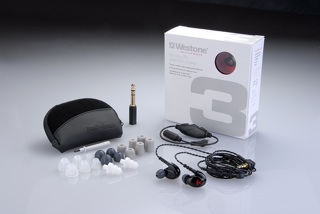I fancy myself an audiophile, primarily because of my history. In my earlier years (before kids, minivans, and car seats), much of my discretionary income went to high-end audio equipment and source music. I still have my B&W 801s, but they are relegated to the basement.
Like most of you, most of my music is now personal. I carry my iPhone everywhere, and my 80GB iPod on my travels. The limitations of the digital sources are not nearly as challenging as the limitations of the sound transducers... those little micro-speakers that you stick on or over your ears.
That is changing dramatically.
Two years ago, before a trip to teach skiing in Europe, I picked up a pair of Westone UM2 in-ear monitors to make the long plane flights more bearable. I had taken to using earplugs to block noise because I arrived less fatigued, and my musician and audio expert friends were using UM2s on stage as in-ear monitors.
So, I decided to give them a try, even though they were designed for stage and not personal music devices.
They sound very nice, but aren't quite the top-end audiophile 'phones. At the time, I was hearing rumors about a three-way design that Westone was planning (three speakers in each ear, one each for high-, mid- and low-frequency reproduction), but it wasn't available, yet. So, I settled in with the UM2s.
Last November, Westone released the Westone 3, their first earphones designed for the discriminating consumer and audiophile. They are, without question, the finest in-ear speaker system available today.
Shortly after I received my pair, I tested them at home and on domestic plane flights. Then, after Christmas, I headed off on another long trip to Europe (this time to Frankfurt and back) to test them in a noisy environment for a long period of time. I tested them on my iPhone, my video iPod, airplane audio systems (more on those in a minute), and computers.
The executive summary: an audiophile's dream in-ear sound transducers.
First, what you get:

The box comes backed full of eartips so that you can find the ones the work just right for you, including foam tips for soft, noise-blocking fit; Shure baffle-style, and the mushroom-style that is familiar from other earphones on the market. In addition, you also have an in-line volume control, an adapter to make the Westone 3 compatible with standard headphone ports, and a pouch for carrying them.
That's a lot in a relatively small package, and the 3s pack a punch.
I listened to the 3s reproducing music as varied as Dvo?ák and Genesis. The personal entertainment system on United's new Boeing 767 international business class allowed me to test with music beyond my own 53GB digital library, and to see how they handled both quiet sections of orchestral music, subtleties of jazz vocals, and even the interesting crackle of tower communication. Regardless what I listened to, the eartips blocked most background noise, allowing me to listen in peace whether awake or asleep (Westone specifies 25 dB passive noise attenuation).
I will say that I am not one who likes active noise canceling. I think it messes with the audio too much. As an electrical engineer, I certainly understand the theory behind it, but I also recognize the distortion that the process introduces. That's why I prefer the passive approach that Westone uses, and together with the exceptional sonic characteristics of the units, you will find a very pleasant experience, indeed.
Bass? From these tiny things?
One of the primary areas missing from headphones and earphones is effective, clear bass. In the case of the Westone 3, you will be pleasantly surprised. The deep bass pedals of Genesis' Suppers Ready (from their live Seconds Out album) and the deep echoes on the Chant album (by The Benedictine Monks of Santo Domingo de Silos) were clear and deep. I almost felt that I could feel them, but decided it can't be possible that I would feel bass from these small devices.
Similarly, treble was clear and without coloration, with strings and woodwinds sounding natural and not strident.
The bottom line is that these are as sonically close to a studio monitor as I have yet heard. For anyone who is looking for ways to enjoy music in more places (and who isn't?) without the expected compromise in quality, I highly recommend the Westone 3s.


 . I combined the enclosure with four
. I combined the enclosure with four  , and a
, and a  .
.